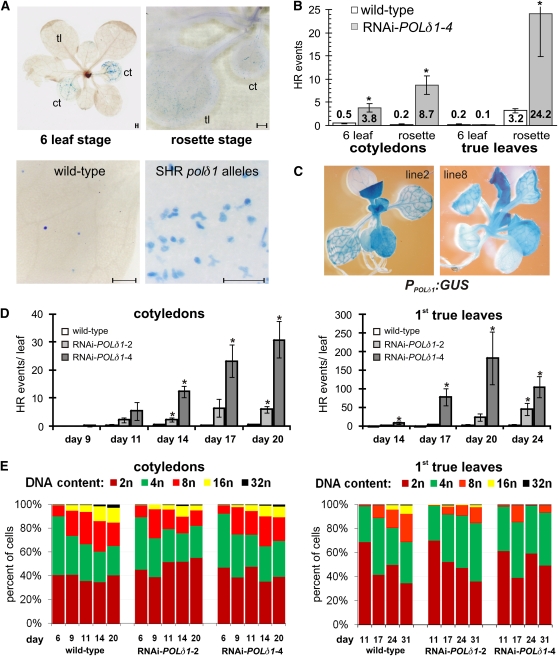Figure 4.
The HR Events of Mutant Plants with Reduced POLδ1 Levels and of Wild-Type Plants Originate in Endoreduplicating Somatic Cells.
The spatial and temporal appearance of HR events was analyzed in representative mutant plants with strong polδ1 alleles (SHR class) in the GUS-based inverted repeat background (line IR1).
(A) Top panel: At early developmental stages, HR events are mostly observed in cotyledons (ct); with progressing age, many of the HR events also occur on true leaves (tl). Bottom panel: Close-up of HR events in true leaves of rosette stage wild-type and SHR class mutant plants, predominantly appearing as staining of single cells. Bars = 1 mm.
(B) Incidences of HR in cotyledons and true leaves were statistically analyzed in line RNAi-POLδ1-4 at an early (six leaf) and late (rosette) developmental stage (n ≥ 6 plants).
(C) Transcriptional activity of POLδ1 promoter fused to GUS reporter gene, monitored in two independent Arabidopsis lines.
(D) The occurrence of HR events in cotyledons and in the first true leaves of wild-type and two RNAi-POLδ1 mutant plant lines was followed over time (days after germination). Error bars indicate standard error of HR events/plant in the assessed plant population (n ≥ 12).
(E) In parallel, nuclear DNA content was measured and the degree of endoreduplication cycles was estimated by the relative distribution of ploidy levels (n ≥ 2). Asterisks indicate significant differences between mutant and wild-type plants.

